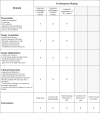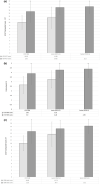The Ultrasound Competency Assessment Tool (UCAT): Development and Evaluation of a Novel Competency-based Assessment Tool for Point-of-care Ultrasound
- PMID: 34041429
- PMCID: PMC8138101
- DOI: 10.1002/aet2.10520
The Ultrasound Competency Assessment Tool (UCAT): Development and Evaluation of a Novel Competency-based Assessment Tool for Point-of-care Ultrasound
Abstract
Objectives: Point-of-care ultrasound (POCUS) has become an integral diagnostic and interventional tool. Barriers to POCUS training persist, and it continues to remain heterogeneous across training programs. Structured POCUS assessment tools exist, but remain limited in their feasibility, acceptability, reliability, and validity; none of these tools are entrustment-based. The objective of this study was to derive a simple, entrustment-based POCUS competency assessment tool and pilot it in an assessment setting.
Methods: This study was composed of two phases. First, a three-step modified Delphi design surveyed 60 members of the Canadian Association of Emergency Physicians Emergency Ultrasound Committee (EUC) to derive the anchors for the tool. Subsequently, the derived ultrasound competency assessment tool (UCAT) was used to assess trainee (N = 37) performance on a simulated FAST examination. The intraclass correlation (ICC) for inter-rater reliability and Cronbach's alpha for internal consistency were calculated. A statistical analysis was performed to compare the UCAT to other competency surrogates.
Results: The three-round Delphi had 22, 26, and 26 responses from the EUC members. Consensus was reached, and anchors for the domains of preparation, image acquisition, image optimization, and clinical integration achieved approval rates between 92 and 96%. The UCAT pilot revealed excellent inter-rater reliability (with ICC values of 0.69-0.89; p < 0.01) and high internal consistency (α = 0.91). While UCAT scores were not impacted by level of training, they were significantly impacted by the number of previous POCUS studies completed.
Conclusions: We developed and successfully piloted the UCAT, an entrustment-based bedside POCUS competency assessment tool suitable for rapid deployment. The findings from this study indicate early validity evidence for the use of the UCAT as an assessment of trainee POCUS competence on FAST. The UCAT should be trialed in different populations performing several POCUS study types.
© 2020 by the Society for Academic Emergency Medicine.
Figures


Similar articles
-
From novice to proficient: a longitudinal study of POCUS skill development through a hybrid certification program in the United Arab Emirates.BMC Med Educ. 2025 Apr 17;25(1):568. doi: 10.1186/s12909-025-07138-2. BMC Med Educ. 2025. PMID: 40247259 Free PMC article.
-
The ultrasound competency assessment tool for four-view cardiac POCUS.Ultrasound J. 2021 Sep 27;13(1):42. doi: 10.1186/s13089-021-00237-3. Ultrasound J. 2021. PMID: 34570287 Free PMC article.
-
External validation of the ultrasound competency assessment tool.AEM Educ Train. 2023 Jun 22;7(3):e10887. doi: 10.1002/aet2.10887. eCollection 2023 Jun. AEM Educ Train. 2023. PMID: 37361190 Free PMC article.
-
Evaluation of Trainee Competency with Point-of-Care Ultrasonography (POCUS): a Conceptual Framework and Review of Existing Assessments.J Gen Intern Med. 2019 Jun;34(6):1025-1031. doi: 10.1007/s11606-019-04945-4. J Gen Intern Med. 2019. PMID: 30924088 Free PMC article. Review.
-
Time to FOCUS - 'Palliative Medicine Point-of-Care Ultrasound'.Indian J Palliat Care. 2023 Jan-Mar;29(1):36-45. doi: 10.25259/IJPC_274_2022. Epub 2023 Jan 12. Indian J Palliat Care. 2023. PMID: 36846289 Free PMC article. Review.
Cited by
-
Change in economy of ultrasound probe motion among general medicine trainees.Ultrasound J. 2024 Jan 30;16(1):5. doi: 10.1186/s13089-023-00345-2. Ultrasound J. 2024. PMID: 38289444 Free PMC article.
-
An Interdisciplinary Approach to the Introduction of Point-of-Care Ultrasound in an Urban Academic Primary Care Center.Cureus. 2023 Mar 18;15(3):e36329. doi: 10.7759/cureus.36329. eCollection 2023 Mar. Cureus. 2023. PMID: 37077608 Free PMC article.
-
Point-of-Care-ultrasound in undergraduate medical education: a scoping review of assessment methods.Ultrasound J. 2023 Jun 11;15(1):30. doi: 10.1186/s13089-023-00325-6. Ultrasound J. 2023. PMID: 37302105 Free PMC article.
-
From novice to proficient: a longitudinal study of POCUS skill development through a hybrid certification program in the United Arab Emirates.BMC Med Educ. 2025 Apr 17;25(1):568. doi: 10.1186/s12909-025-07138-2. BMC Med Educ. 2025. PMID: 40247259 Free PMC article.
-
Design of a point-of-care ultrasound curriculum for pediatric emergency medicine fellows: A Delphi study.AEM Educ Train. 2021 Aug 1;5(4):e10700. doi: 10.1002/aet2.10700. eCollection 2021 Aug. AEM Educ Train. 2021. PMID: 34901685 Free PMC article.
References
-
- Solomon SD, Saldana F. Point‐of‐care ultrasound in medical education—stop listening and look. N Engl J Med 2014;370:1083–5. - PubMed
-
- American College of Emergency Physicians . Ultrasound guidelines: emergency, point‐of‐care and clinical ultrasound guidelines in medicine. Ann Emerg Med 2017;69:e27–54. - PubMed
-
- Olszynski P, Kim DJ, Chenkin J, Rang L. The CAEP emergency ultrasound curriculum ‐ objectives and recommendations for implementation in postgraduate training: executive summary. CJEM 2018;20:736–8. - PubMed
-
- Blehar DJ, Barton B, Gaspari RJ. Learning curves in emergency ultrasound education. Acad Emerg Med 2015;22:574–82. - PubMed
LinkOut - more resources
Full Text Sources

